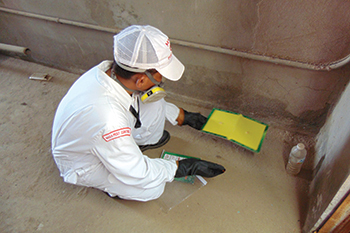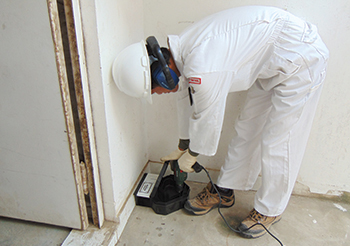
IPM involves integrating multiple control methods based on site information obtained through inspection, monitoring and reports.
IPM methods reduce environment impact
GANGADHAR SIVASWAMY of Masa* highlights why integrated pest management (IPM) techniques are crucial to protecting the environment and ensuring the health and safety of all life forms.
01 December 2018
The environment is being polluted in many different ways: factories are discharging waste directly into rivers and seas, fertilisers and pesticides are getting mixed with water, and harmful gases and substances are produced by polythene burning, among other factors.
Water scarcity is now the biggest threat to global food security and air pollution has similarly become a serious concern. Global warming is real, and so is the importance of protecting the environment.
Our ecosystem serves as a means of sustenance for humans and all other species that are essential to our well-being, quality of life and survival.
 |
|
Shieshakly ... guiding Masa toward progress. |
Pollution endangers both man and animals, and man-made disruptions to ecosystems can cause extinction. We must save water and preserve our natural resources for our future generations.
With regards to the usage of pesticides, although these are beneficial to crops, they pose a serious negative environment impact and may lead to the destruction of biodiversity.
Pesticides can contaminate soil, water, and vegetation. In addition to killing insects or weeds, pesticides can be toxic to a host of organisms including birds, fish, beneficial insects, and non-target plants.
The survival of birds and aquatic creatures is under threat from harmful and excessive use of pesticides.
Many pesticides contain potentially toxic chemicals that can cause diseases such as cancer and neurological and reproductive disorders. In addition, pesticides can flow into lakes and streams when it rains.
In order to protect the environment, pest control companies need to restrict the use of chemicals and rely on non-chemical methods to control pests.
In this regard, Saudi-based Masa Establishment for Pest Extermination Services encourages integrated pest management (IPM) techniques while offering pest control services to its customers.
IPM is an environment-friendly, common-sense approach to controlling pests. Contrary to traditional pest control methods, which involve routine application of pesticides, IPM focuses on pest prevention and application of pesticides only as needed. This provides a more effective, environmentally sensitive approach to controlling pests.
 |
|
Masa technicians at work in the field. |
IPM programmes take advantage of all appropriate pest management strategies, including the judicious use of pesticides. Preventive pesticide application is limited because the risk of pesticide exposure may outweigh the benefits of control, especially when non-chemical methods provide the same results.
IPM is not a single pest control method but rather involves integrating multiple control methods based on site information obtained through inspection, monitoring and reports. Consequently, every IPM programme is designed based on the pest prevention goals and eradication needs of the situation.
IPM programmes mainly use a four-tiered implementation approach:
• Identify pests and monitor progress: Correct pest identification is required to determine the best preventive measures and reduce the unnecessary use of pesticides. Additionally, correct identification will prevent the elimination of beneficial organisms.
• Set action thresholds: An action threshold is the pest population level at which the pest’s presence is a nuisance, health hazard, or an economic threat. Setting an action threshold is critical to guiding pest control decisions. A defined threshold will focus on the size, scope, and intensity of an IPM plan.
• Prevent proliferation of pests: IPM focuses on prevention by removing conditions that attract pests, such as food, water, and shelter. Preventive actions include reducing clutter, sealing areas from where pests enter (weatherisation), removing trash and overgrown vegetation, maintaining clean dining and food storage areas, installing pest barriers, removing stagnant water, and educating building occupants on IPM.
• Control pests: Pest control is required if action thresholds are exceeded. IPM programmes use the most effective, lowest risk options considering the risks to the applicator, building occupants, and environment. Control methods include pest trapping, heat/cold treatment, physical removal and pesticide application.
Pesticide use may be necessary in an IPM programme to effectively control pest infestations, but should only be used after non-chemical methods have failed. Application should be done as a last resort and in a manner that will maximise effectiveness in controlling the target pest and minimise its exposure to humans and other non-target species.
IPM practices such as trapping, screening, caulking, steam cleaning and power washing are effective long-term pest control methods. Non-pesticide pest control practices can be effective and applied with a high degree of safety.
IPM helps to reduce the number of pests; over the long term, there will be fewer pests to annoy or threaten the residents.
Reducing the number of pesticide applications means a reduction of pollutants (pesticides) in the environment and this reduces potential harmful effects on humans, wildlife, environment, and future generations.
Developing and implementing an IPM allows the applicator to deliver more effective pest control programmes.
* Masa Establishment for Pest Extermination Services is a 100 per cent Saudi company under the full ownership and direction of Mousaied Shieshakly. Established in 1980, Masa has gained a strong, stable foothold in the pest control industry in Saudi Arabia through strict observance and maintenance of high quality service standards. Masa’s head office is located in Jeddah and it has a team of highly qualified staff. The company has 12 branches across the kingdom, including in Riyadh and Buraidah (Central Region); Dammam, Al Ahsa (Hofuf), and Jubail (Eastern Region); Jeddah, Makkah and Madinah (Western Region); and Abha and Jizan (West/Southern region); and Tabuk (Northern region).


